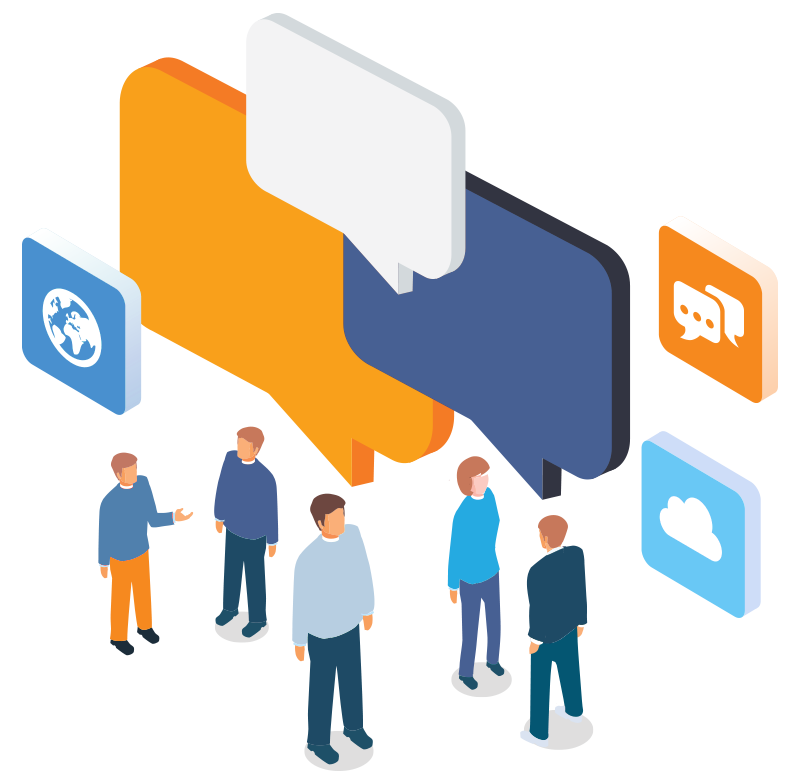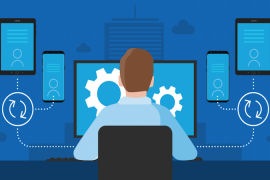In today’s world, as businesses are expanding to several countries, it is difficult to deliver their services to the local people due to language barriers. These businesses need to translate their services into the local language for better understanding by local customers. Translating bulk quantities of material can be a daunting task if not for translation management systems.
Finding the perfect translation management system can be quite nerve-wracking, considering the influx of translation management systems in recent years. To calm your nerves, we at SaaSworthy have put together a list of the 8 top translation management systems that you can use in 2021.
Table of Contents
What is a Translation Management System?

Translation software helps worldwide commerce and international business communication by instantly translating a document from its source language into a variety of other languages using built-in dictionaries. Each language’s grammar and syntax rules are shuffled during the translation process by the translation management system.
Translation management systems are used by translators and interpreters to generate, translate, correct, edit, save, manage, organize, and publish translation and interpretation projects. Its goal is to employ automation to simplify the entire translation process.
The 8 Top Translation Management Systems to use in 2021
Given below is a list of the 8 top translation management systems in 2021. The features and limitations of each software are given in detail so that you can choose the best one that suits your needs.
1. Lokalise
Lokalise, founded in 2017, is one of the fastest-growing multi-platform translation management systems, focusing on the app, website, and game translation and localization. The best thing about Lokalise is that it automatically recognizes new or modified information on a website and incorporates it into the translation workflow.
With over 1500 users, Lokalise is SaaSworthy’s recommendation if you are looking for a translation management system 2021 free download.
The various features of Lokalise include-
- You can upload Sketch Artboards to Lokalise or share screenshots between Figma or Adobe XD and Lokalise, allowing translators to begin work before production begins.
- You can centralize your translation material and share the workspace with product and marketing teams who can extract information from several sources like GitHub, WordPress, etc.
- You can set up automated processes utilizing preset custom rules, API and webhooks, or interface with services like GitHub, Slack, etc.
- You can work with your own team, freelancers, the community, partner agencies, or bigger LSPs to translate. Machine translation engines such as Google and DeepL provide instantaneous results.
The limitations of Lokalise are-
- The search bar and results section need improvements.
- Navigating through the software can be challenging due to its complex user interface.
2. Transifex
Transifex is an all-in-one translation management system that allows translators and linguists to quickly and easily translate a mobile app, website, desktop software, games, video, or subtitles. It offers an open platform that allows material and translations to be automatically synchronized to a worldwide content repository that is always accessible.
You can integrate it with the translation development process, systems, and apps, and the CMS. Transifex is SaaSworthy’s top choice as the best translation management system 2021.
The various features of Transifex include-
- It enables the customization of translation workflows, thorough reporting, and collaboration. It also comes with a glossary, a translation editor with Translation Memory, context, and placeholders.
- Transifex’s online editor allows all translators, agencies, reviewers, and marketers to access and control the translation process without the need for numerous documents.
- All users can be managed from a single location by establishing communities and groups, and access can be limited by allocated responsibilities.
- It readily handles language files like Yaml, Gettext, and XLIFF, and its advanced translation memory engine that manages content quickly and effectively makes it the best suited for developers.
The limitations of Transifex are-
- It lacks the complexity of workflow customization, making the localization process challenging.
- There are some difficulties with permissions and the initial setup.
3. EasyTranslate
EasyTranslate is a browser-based top translation management system that acts as a supercharger for your translation and content localization operations. It allows organizations to develop and translate material, monitor projects, connect with internal or external teams, and hire freelance translators.
It employs artificial intelligence to assist you in finding the best translators for your projects. With the help of an e-learning platform, you can train and onboard your own staff of experienced translators.
The various features of EasyTranslate include-
- It employs machine translation to speed up the translation process, and customers can control the AI-powered process on their own. Clients can also work with interpreters and expert proofreaders to correct translation mistakes in many languages.
- By utilizing the Language-as-a-Service platform offered by EasyTranslate, organizations may evaluate translators and content writers before hiring them.
- It enables businesses to work with EasyTranslate teams for the quality control process and further support with external translators.
- It helps you establish your personalized process, automate your translations, monitor your projects, and communicate with your external or in-house staff.
The limitations of EasyTranslate are-
- The user experience is not friendly, and a lot of tools need improvements in their user interface.
- There are some bugs that occur occasionally.
4. GlobalLink
GlobalLink is a cloud-based translation management system that has been assisting enterprises in simplifying the process of developing, managing, and delivering global content for over two decades. It reduces project management time and eliminates time-consuming procedures by centralizing the localization process.
GlobalLink gives its users the automation and efficiency they require to fulfill their expanding business demands today and in the future.
The various features of GlobalLink include-
- Its enterprise localization platform offers customizable processes, reporting, CMS integration, and multi-vendor management in both hosted and on-premise deployment models.
- It provides products, services, apps, training, and content in the local language and in a culturally acceptable way.
- Its web-based terminology management tool, Term Manager, enables translation managers to alter, evaluate, search for, and remove existing words in order to deliver a uniform and accurate message every time.
- The GlobalLink TM Server is a powerful, dependable, and scalable translation memory system that enables translation memories to be exchanged in real-time across the company.
The limitations of GlobalLink are-
- It is an expensive option when compared to other translation management software offering similar features.
- It requires you to convert non-MS Office files into Office files before uploading.
5. Smartling
Smartling, founded in 2009, is a cloud-based top translation management system for localizing websites, documents, and mobile apps. You can reach people worldwide with Smartling’s Translation Management Platform without requiring specialized coding skills.
Smartling has been named the #1 Leader of the 2019 MarketFlex for Language-Oriented TMS by CSA Research. Its core competencies are process automation and integration with different content management, code repository, eCommerce, marketing automation, and customer support tools.
The various features of Smartling include-
- Its various computer-assisted translation features include localization automation, machine translation, quality control, terminology management, translation analytics, and a translator database.
- It captures material automatically from your website or app, facilitates human translation, and then returns the translated text. You can also create your own glossary and style guide for your translators to follow.
- From the Smartling dashboard, you can check statistics and analytics to acquire a better knowledge of page visits, most popular languages, particular URL usage, and so on.
- Smartling’s customized workflows can manage any sort of translation you prefer: human translation, machine translation, volunteer, non-professional, etc.
The limitations of Smartling are-
- The complex dashboard is overwhelming and not user-friendly.
- It has a steep learning curve which makes it challenging for new users.
6. Crowdin
Crowdin is a team-oriented cloud-based translation management system. You can keep all of the sources and translated files in a single location that is easily accessible at all times.
Crowdin was established in 2009 and has grown into a company with over a million registered users globally to help deliver their content in their customers’ native language. Crowdin is, therefore, SaaSworthy’s top recommendation as the best free translation management system in 2021.
The various features of Crowdin include-
- By automating the source and translated file sync with GitHub, Android Studio, Google Play, and other services, you can save time and help accelerate product localization.
- You can outsource translations to translation agencies, employ your own staff to translate your material, or use a combination of the two using Crowdin.
- Your source content is always up to date owing to integrations and version control, and previously-translated materials are immediately imported into translation memory.
- By pre-translating your project using Translation Memory or Machine Translation, you can speed up the translation process while reducing human labor.
The limitations of Crowdin are-
- It does not include the read-only permission option for users.
- The user interface is not intuitive, and there is no option to retrieve accidentally erased translated content.
7. Phrase
Phrase, formerly PhraseApp, is a translation management system designed especially for software developers. It enables teams of all sizes to scale their translation operations through intelligent automation, which significantly reduces processing overhead.
The platform provides users with APIs as well as integration tools. Phrase enables direct interaction with translators. It sources ideas from across the world, making it one of the top translation management systems.
The various features of Phrase include-
- Glossary, Translation Memory, In-Context Editor, SmartSuggest, Checks, and more tools are available to help you enhance the quality and consistency of your translations.
- It is useful for developers since it has command-line tools and a robust translation storage engine for managing content.
- You can organize all of your translation projects by assigning team members and giving due dates to your preferred locales. Its access rights management capability enables large businesses to effectively manage projects and users.
- The API allows you to easily import and download local files and tag keys and interact with the localization data contained in Phrase in various ways.
The limitations of Phrase are-
- Working with multiple keys can be challenging and requires reloading.
- It takes longer to load, and the changes do not get saved automatically.
8. Memsource
Established in 2010, Memsource is a translation management system free that helps companies with their translation and localization workflows by combining artificial intelligence with traditional translation technologies. It also includes a fully-featured CAT tool to assist linguists and project managers across all devices.
It offers a natural yet robust language translation system capable of processing two billion words each month from more than 200,000 users worldwide.
The various features of Memsource include-
- Memsource supports 500+ languages, 50+ file formats, and 30+ machine translation engines. Its AI-powered solution lowers translation expenses while increasing quality.
- It provides end-to-end automation through content pulls from third-party systems such as Zendesk, GitHub, and others.
- It gives you the freedom to create personalized integrations using the Memsource REST API and also provides CMS connectors and robust workflow automation out of the box.
- It detects text that can be translated using machine engines and routes it to the relevant engine. It can route content that needs human translation directly to approved translators or let you decide.
The limitations of Memsource are-
- The subscription plans and features are not flexible as per the requirements of the organization.
- The web-based editor can become slow during large projects.
Conclusion
We hope that we were able to throw some light on the various translation management systems available in the present market scenario. The free options are best suited for freelancers and small businesses, while the paid ones are suitable for medium and large-scale enterprises. Now that you have reviewed the 8 top translation management systems, you can select the one that is best tailored to your requirements.
For more informative articles like this one detailing the features and limitations of the top software in each category, visit the SaaSworthy blog.




![10 Best Free and Open-Source Landscape Design Software in 2024 [Updated] SaaSworthy Blog Header](https://images.saasworthy.com/blog_latest/wp-content/uploads/2021/04/Blog-Header-Image.png)

